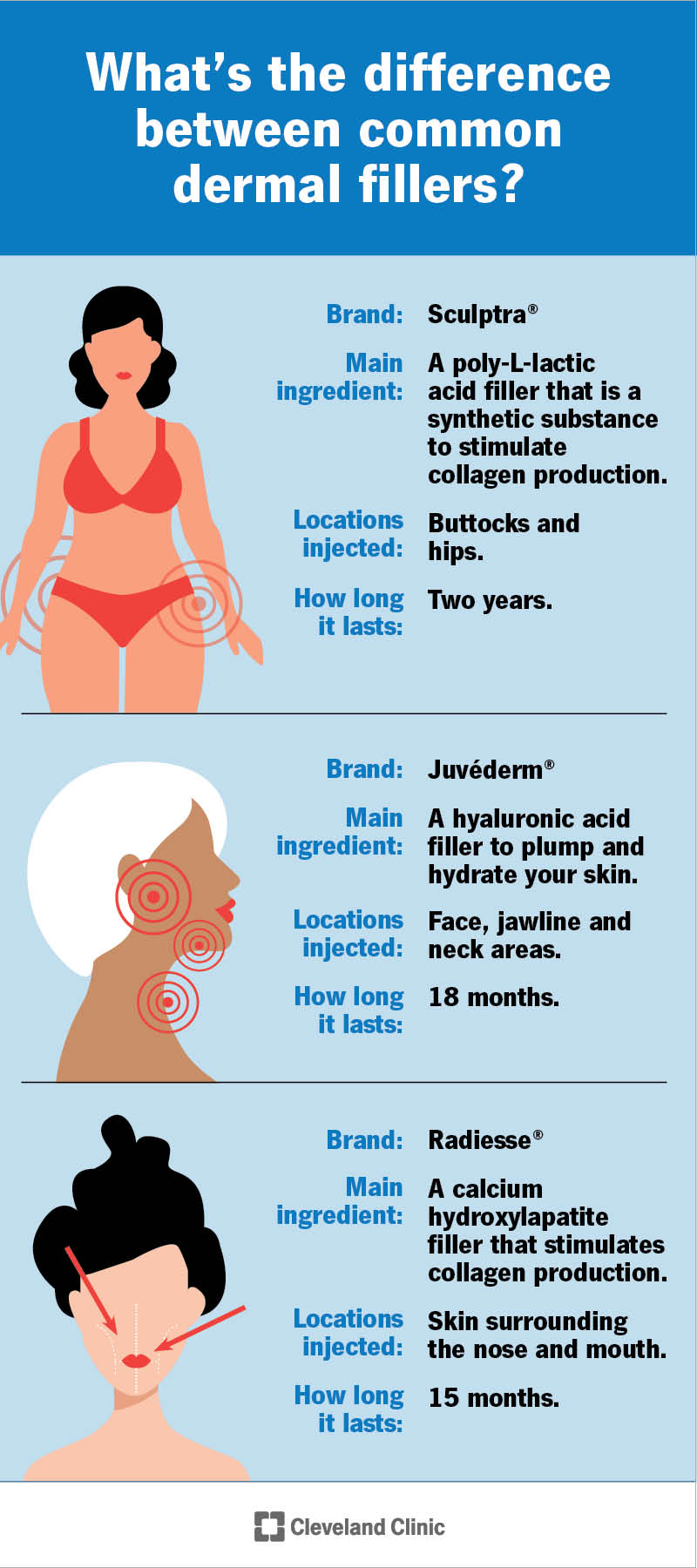Sculptra is a type of dermal filler. This cosmetic procedure uses FDA-approved poly-L-lactic acid to reduce deep wrinkles in your skin. This filler is noninvasive. A healthcare provider will inject Sculptra into your skin. You can get back to normal activities quickly, but it may take four to six weeks to see full results after the procedure.
Advertisement
Cleveland Clinic is a non-profit academic medical center. Advertising on our site helps support our mission. We do not endorse non-Cleveland Clinic products or services. Policy
Sculptra® is a type of dermal filler, which is a cosmetic procedure to smooth fine lines and deep wrinkles.
Advertisement
Cleveland Clinic is a non-profit academic medical center. Advertising on our site helps support our mission. We do not endorse non-Cleveland Clinic products or services. Policy
Sculptra is a gel-like substance made of poly-L-lactic acid. A healthcare provider will inject this filler underneath your skin where you want a fuller or smoother appearance. Poly-L-lactic acid is a collagen stimulator that absorbs into your body a few days after treatment to encourage your cells to produce more collagen. Collagen is a protein in your skin — as well as in your connective tissues, bones and cartilage — that provides structure, support and strength.
You might get Sculptra injected into areas of your body where you have lines and wrinkles that you want smoothed out. The most common areas of Sculptra injections include:
You might be interested in cosmetic dermal fillers using Sculptra if you want to:
Dermal fillers like Sculptra can last more than two years. Sculptra isn’t a permanent solution to deep wrinkles. You may need multiple injections every few years to maintain your results.
Sculptra is a type of dermal filler. There were approximately 3,410,730 soft tissue dermal fillers performed in the United States in 2020. Of that number, 134,123 procedures were completed with Sculptra.
Advertisement
Before a dermal filler procedure, you’ll meet with a healthcare provider who specializes in fillers. They’ll perform a consultation to learn more about you, including your:
During this consultation, your provider may:
Dermal fillers using Sculptra are nonsurgical cosmetic procedures that you’ll receive during an office visit. You’ll be awake during the procedure. The steps of a Sculptra injection include:
When your provider completes the Sculptra injection, you’re free to go about your normal activities without interruption. You’ll want to avoid strenuous activities for a couple of days. There may be bruising or swelling at the injection site that will go away after a couple of days. If you feel sore, you can take over-the-counter NSAIDs as your provider advises. Within about a month of injection, you should start to notice that your skin looks plumper or fuller.
Yes, Sculptra is a safe form of dermal filler. It’s U.S. Food and Drug Administration (FDA)-approved. Your healthcare provider will advise you on whether you’re a candidate for the procedure based on your current health status and goals. It may not be an effective procedure if you’re allergic or sensitive to any of the filler’s components or if you have trouble healing after an injury.
Advantages of getting a Sculptra dermal filler include:
As with all cosmetic procedures, there are risks or side effects that could happen, but they’re rare. The risks of Sculptra include:
Advertisement
Sculptra injections are noninvasive procedures, and the healing time is relatively quick compared to other cosmetic treatments. Your skin might be sore, and you could have light bruising at the injection site for a couple of days. Avoid exercising or strenuous activities for at least 24 hours after the injection. You’ll be well enough to return to your daily activities immediately after the procedure.
If you have bruising that lasts longer than a week or severe pain at your injection site that doesn’t resolve by taking over-the-counter NSAIDs, contact your healthcare provider.

Image content: This image is available to view online.
View image online (https://my.clevelandclinic.org/-/scassets/images/org/health/articles/24676-sculptura)
There are a lot of dermal fillers available. A healthcare provider who specializes in cosmetic procedures can help you pick the right filler based on your goals for the treatment. Common dermal fillers in addition to Sculptra include:
A hip dip is the shape of your pelvis where your hip bone is higher than your femur. A hip dip causes your muscles and fat to curve inward. You can find hip dips where your hip meets your thigh. Not everyone has a hip dip.
Advertisement
Some people with hip dips don’t like the indentation and choose to get dermal fillers like Sculptra to smooth out this area.
Sculptra is a safe cosmetic procedure to reduce deep wrinkles. You might be interested in Sculptra if you have recesses, indentations or fine lines that you want eliminated on your skin. Sculptra can last over two years, but it’s not a permanent cosmetic procedure, so you may need fillers every few years to maintain your results.
Advertisement
Learn more about the Health Library and our editorial process.
Cleveland Clinic's health articles are based on evidence-backed information and review by medical professionals to ensure accuracy, reliability, and up-to-date clinical standards.
Cleveland Clinic's health articles are based on evidence-backed information and review by medical professionals to ensure accuracy, reliability, and up-to-date clinical standards.
Every day, people see your skin, hair and nails. At Cleveland Clinic, our expert and caring dermatology team will make sure they’re healthy and strong.
